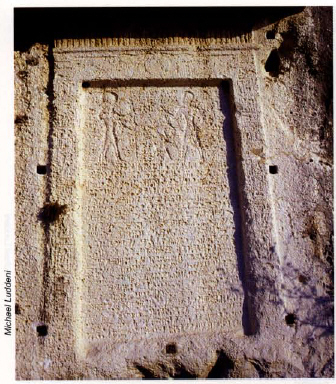Nahr el-Kalb (Dog River) -- By: Michael C. Luddeni
Journal: Bible and Spade (Second Run)
Volume: BSPADE 15:4 (Fall 2002)
Article: Nahr el-Kalb (Dog River)
Author: Michael C. Luddeni
BSpade 15:4 (Fall 2002) p. 102
Nahr el-Kalb
(Dog River)

Just a few miles north of Bierut, the Dog River (Nahr el-Kalb) flows west from the Lebanon mountains to the Mediterranean Sea. The river’s mouth is a deep gorge cut through a limestone bluff rising up from the shoreline. It was a significant natural boundary and made the river difficult to cross. For whatever reason, ancient armies decided to take time to commemorate their safe arrival at the Dog River by carving stelae along the pathway leading down the limestone bluff to the river.
From 1292 BC to AD 1942 Pharaohs, Kings, Sultans, Emperors & Generals Have Left Their Calling Cards On These Rocky Cliffs.
Called the Lycus River in antiquity, its modern Arabic name is Nahr el-Kalb. Translated “Dog River” in English, the name is attributed to the legend of a wolf statue once sitting on a rock plinth just past a Greek inscription along the southern bank at the river’s mouth. One local tradition says the statue would howl as a warning against invaders. Supposedly, in 1942, Australian soldiers working on the nearby railway uncovered a large but badly damaged wolf statue. Unfortunately, its whereabouts today is unknown. If there really was a wolf statue, and if it really did howl at times, possibly the wind blowing through a hollow place of the statue may have produced an unusual sound.
All the inscriptions were carved on the southern bank of the river, except King Nebuchadnezzar’s sixth century BC cuneiform inscription carved into the river’s north bank. Monuments carved before 1920 have been catalogued and designated by Roman numerals.
During the reign of Rameses II (1279–1212 BC), Egypt was losing control over the northern part of its empire in Syria to the Hittites. Rameses II launched a campaign in the fourth year of his reign leading his troops along the coast as far north as the Dog River. In the spring of the next year he led his army into Syria and met the Hittites. The battle was not decisive, but established the boundary between Egypt and Hati at the Dog River. An alliance was concluded between Rameses II and the Hittite king Khattusilis. They were not to encroach on each other’s territory and pledged to render assistance in case of attack from any other power. The friendship that followed was cemented by the marriage of the daughter of King Khattusilis and Rameses II. Rameses II commemorated his passage at the Dog River by carving three stelae in the cliff side. The cliff acted as a natural barrier to hold off invading armies along the coast going north or south.
BSpade 15:4 (Fall 2002) p. 103

Click here to subscribe
